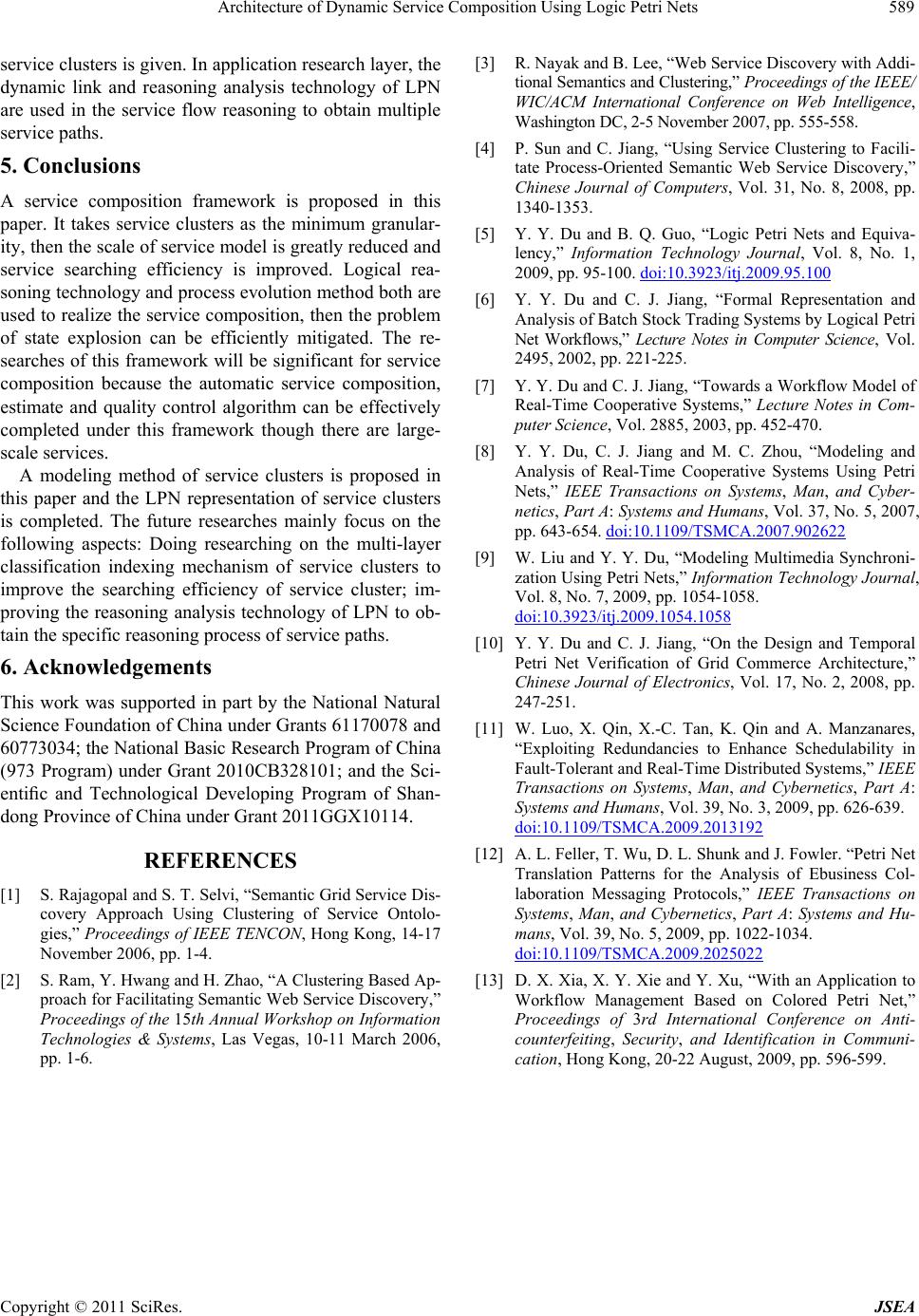
Architecture of Dynamic Service Composition Using Logic Petri Nets589
service clusters is given. In application research layer, the
dynamic link and reasoning analysis technology of LPN
are used in the service flow reasoning to obtain multiple
service paths.
5. Conclusions
A service composition framework is proposed in this
paper. It takes service clusters as the minimum granular-
ity, then the scale of service model is greatly reduced and
service searching efficiency is improved. Logical rea-
soning technology and process evolution method both are
used to realize the service composition, then the problem
of state explosion can be efficiently mitigated. The re-
searches of this framework will be significant for service
composition because the automatic service composition,
estimate and quality control algorithm can be effectively
completed under this framework though there are large-
scale services.
A modeling method of service clusters is proposed in
this paper and the LPN representation of service clusters
is completed. The future researches mainly focus on the
following aspects: Doing researching on the multi-layer
classification indexing mechanism of service clusters to
improve the searching efficiency of service cluster; im-
proving the reasoning analysis technology of LPN to ob-
tain the specific reasoning process of service paths.
6. Acknowledgements
This work was supported in part by the National Natural
Science Foundation of China under Grants 61170078 and
60773034; the National Basic Research Program of China
(973 Program) under Grant 2010CB328101; and the Sci-
entific and Technological Developing Program of Shan-
dong Province of China under Grant 2011GGX10114.
REFERENCES
[1] S. Rajagopal and S. T. Selvi, “Semantic Grid Service Dis-
covery Approach Using Clustering of Service Ontolo-
gies,” Proceedings of IEEE TENCON, Hong Kong, 14-17
November 2006, pp. 1-4.
[2] S. Ram, Y. Hwang and H. Zhao, “A Clustering Based Ap-
proach for Facilitating Semantic Web Service Discovery,”
Proceedings of the 15th Annual Workshop on Information
Technologies & Systems, Las Vegas, 10-11 March 2006,
pp. 1-6.
[3] R. Nayak and B. Lee, “Web Service Discovery with Addi-
tional Semantics and Clustering,” Proceedings of the IEEE/
WIC/ACM International Conference on Web Intelligence,
Washington DC, 2-5 November 2007, pp. 555-558.
[4] P. Sun and C. Jiang, “Using Service Clustering to Facili-
tate Process-Oriented Semantic Web Service Discovery,”
Chinese Journal of Computers, Vol. 31, No. 8, 2008, pp.
1340-1353.
[5] Y. Y. Du and B. Q. Guo, “Logic Petri Nets and Equiva-
lency,” Information Technology Journal, Vol. 8, No. 1,
2009, pp. 95-100. doi:10.3923/itj.2009.95.100
[6] Y. Y. Du and C. J. Jiang, “Formal Representation and
Analysis of Batch Stock Trading Systems by Logical Petri
Net Workflows,” Lecture Notes in Computer Science, Vol.
2495, 2002, pp. 221-225.
[7] Y. Y. Du and C. J. Jiang, “Towards a Workflow Model of
Real-Time Cooperative Systems,” Lecture Notes in Com-
puter Science, Vol. 2885, 2003, pp. 452-470.
[8] Y. Y. Du, C. J. Jiang and M. C. Zhou, “Modeling and
Analysis of Real-Time Cooperative Systems Using Petri
Nets,” IEEE Transactions on Systems, Man, and Cyber-
netics, Part A: Systems and Humans, Vol. 37, No. 5, 2007,
pp. 643-654. doi:10.1109/TSMCA.2007.902622
[9] W. Liu and Y. Y. Du, “Modeling Multimedia Synchroni-
zation Using Petri Nets,” Information Technology Journal,
Vol. 8, No. 7, 2009, pp. 1054-1058.
doi:10.3923/itj.2009.1054.1058
[10] Y. Y. Du and C. J. Jiang, “On the Design and Temporal
Petri Net Verification of Grid Commerce Architecture,”
Chinese Journal of Electronics, Vol. 17, No. 2, 2008, pp.
247-251.
[11] W. Luo, X. Qin, X.-C. Tan, K. Qin and A. Manzanares,
“Exploiting Redundancies to Enhance Schedulability in
Fault-Tolerant and Real-Time Distributed Systems,” IEEE
Transactions on Systems, Man, and Cybernetics, Part A:
Systems and Humans, Vol. 39, No. 3, 2009, pp. 626-639.
doi:10.1109/TSMCA.2009.2013192
[12] A. L. Feller, T. Wu, D. L. Shunk and J. Fowler. “Petri Net
Translation Patterns for the Analysis of Ebusiness Col-
laboration Messaging Protocols,” IEEE Transactions on
Systems, Man, and Cybernetics, Part A: Systems and Hu-
mans, Vol. 39, No. 5, 2009, pp. 1022-1034.
doi:10.1109/TSMCA.2009.2025022
[13] D. X. Xia, X. Y. Xie and Y. Xu, “With an Application to
Workflow Management Based on Colored Petri Net,”
Proceedings of 3rd International Conference on Anti-
counterfeiting, Security, and Identification in Communi-
cation, Hong Kong, 20-22 August, 2009, pp. 596-599.
Copyright © 2011 SciRes. JSEA